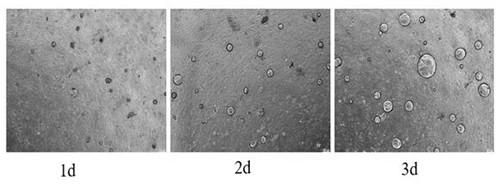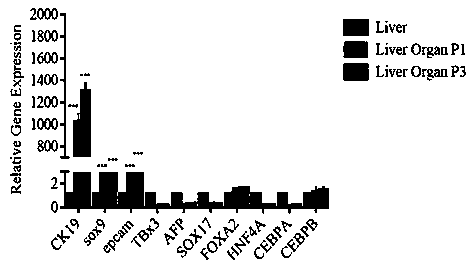In vitro construction method of liver organs and applications
A construction method and organoid technology, applied in cell dissociation methods, artificial cell constructs, biochemical equipment and methods, etc., to achieve the effects of increasing liver-to-body ratio, enhancing proliferation, and alleviating liver function
- Summary
- Abstract
- Description
- Claims
- Application Information
AI Technical Summary
Problems solved by technology
Method used
Image
Examples
Embodiment 1
[0047] Organoid construction in vitro
[0048] 1. Formulation preparation
[0049] 1) Organoid induction medium: choose HepatiCuLt TM OGM Mouse Basal Medium is used as the basal medium for liver organoids, and HepatiCuLt is selected TM OGM Mouse Supplement as liver organoid basal medium supplement, choose Plasmocin TM treatment as an anti-mycoplasma reagent. HepatiCuLt TM OGM Mouse Basal Medium and HepatiCuLt TM Mix OGM Mouse Supplement according to the volume ratio of 10:1, and then add 200uL of Plasmocin TM treatment, mix well and dispense, store at -20°C.
[0050] 2) Digestive solution of liver tissue: take 45mL of Advanced DMEM / F12, add 7.5mL of Dispase and 7.5mL of Collagenase type IV and mix well.
[0051] 2. Take materials
[0052] In an ultra-clean bench, 6-8 week old C57BL / 6 normal mice were selected and killed by cervical dislocation after inhalation anesthesia. The limbs were fixed on the operating table, and the abdomen was disinfected with alcohol c...
Embodiment 2
[0068] Phenotype Characterization of Liver Organoids
[0069] 1. Gene identification:
[0070] 1) Extraction of cellular RNA
[0071] a) Remove the medium from the organoids, rinse twice with PBS to ensure that the residual medium does not affect the purity of the RNA, add 500uL Trizol to one well of the 24-well plate, and repeatedly blow and beat for full lysis, and let stand at room temperature for 10 minutes , after fully separating the protein-nucleic acid complex, transfer it to an enzyme-free 1.5mLEP tube;
[0072] b) Add chloroform at a ratio of 5:1 between Trizol and chloroform, shake vigorously up and down for 10 seconds, and let it stand at room temperature for 5 minutes to allow natural phase separation.
[0073] c) After centrifugation at 12000g for 15 minutes at 4 degrees, carefully collect the upper aqueous phase and transfer it to another new 1.5mL EP tube;
[0074] d) Add an equal volume of isopropanol to the supernatant and mix, and place at -20°C for 1 hou...
PUM
| Property | Measurement | Unit |
|---|---|---|
| Diameter | aaaaa | aaaaa |
Abstract
Description
Claims
Application Information
 Login to View More
Login to View More - R&D
- Intellectual Property
- Life Sciences
- Materials
- Tech Scout
- Unparalleled Data Quality
- Higher Quality Content
- 60% Fewer Hallucinations
Browse by: Latest US Patents, China's latest patents, Technical Efficacy Thesaurus, Application Domain, Technology Topic, Popular Technical Reports.
© 2025 PatSnap. All rights reserved.Legal|Privacy policy|Modern Slavery Act Transparency Statement|Sitemap|About US| Contact US: help@patsnap.com



